Well grown mature houseplants are relatively inexpensive to buy and generally easy to come by, so why do people go through the effort of trying to propagate them?
The main reasons are that although plants can be cheap to purchase, they're almost always cheaper to propagate. It's also very easy too.
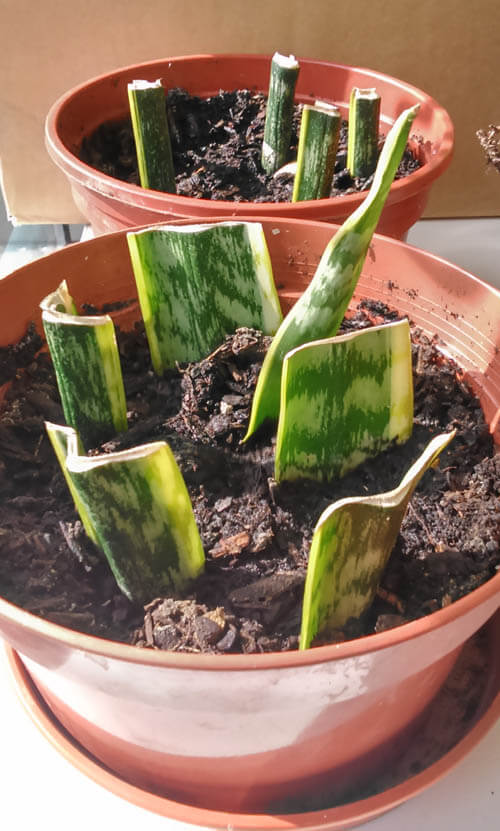
A number of Snake Plant (Sansevieria) being propagated through leaf cuttings.
When it comes to propagating there are many methods to pick from and I explore each of them below. Whether you're increasing your own stock, planning on giving them away to friends and family or wanting to start fresh with a smaller version of an "old friend", I'm going to teach you step by step about creating your own houseplants.
There are several basic rules to remember when it comes to this topic.
Cuttings need roots before they'll "take" and exist by themselves, so if there are no roots at the initial stages you need to encourage the cutting to grow some.
This is done either by planting up the cutting directly in potting compost (Soil method). Or in something like a small container, vase or glass with just water that you change and refresh every few weeks (Water method).
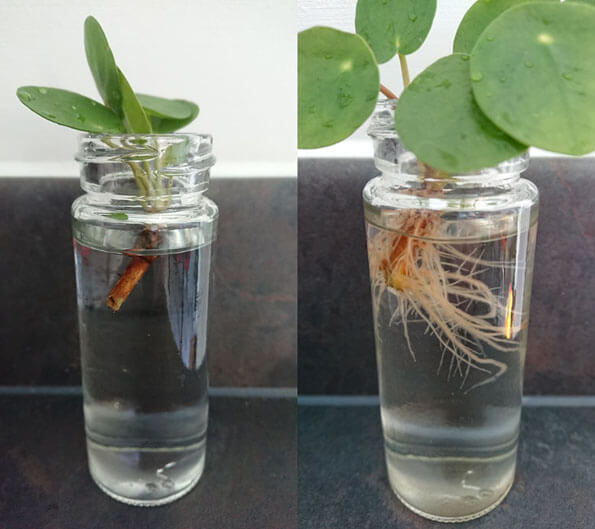
Propagating a Pilea Plant using the water method. Before and after photos.
So which is better? In general, using the soil method tends to reduce the number of steps when it comes to propagation, because once rooting has occurred you just need to grow the plant on.
However do remember that the cutting will need more attention to stop it from being over or underwatered. Also some propagation material just isn't suitable for the water method, so you'll have to use the soil method in those instances.
Which is Best?
Neither method is fail proof so in general I would simply suggest picking the method you like the look of the most or is the most practical for you at the time. Alternatively you could take multiple cuttings and try both.
If you're using the water method you'll eventually have to pot up the new cutting into soil which carries a small risk of failure as you may damage the fragile roots when transplanting. That said the water method is quick and doesn't cost anything. It's a great method if you don't always have access to a garden or compost to hand.
I often get asked about special equipment that might be need for successful propagation. In the majority of cases you can get by with some very basic tools. A pair of kitchen scissors (and if rooting in soil) a simple plant pot and some compost, are sometimes all you need.
That said, you'll often have more success if you use Rooting Hormone Powder and a Heated Propagating Mat. Both of these things encourage roots to form and at a much quicker pace than if you just let nature take it's course. They're not expensive either, as you should be able to buy both together for less than $20 / £15 quite easily.
Obviously if you're only planning to propagate one plant, it's really not going to be worth buying these things.
But if you think you'll do it often, (or are a keen outdoor gardener) they're something to seriously consider as you'll get your money's worth in the long run. A propagating mat sold by Amazon that I use is linked below (affiliate link).
Okay, so you've decided how you would like to root the cuttings. If you know how you're planning on gaining the new plant material then there are some quick jump page links below.
If you're not sure or this is a completely new topic for you, just scroll down the page and decided which method is most suitable for the plant you're trying to propagate. Usually each houseplant can be propagated through a number of different methods so you have a fair amount of choice.
Some species will form side shoots or offsets, usually around the base of itself.
This method is tricky to get right because when you remove the offset you have to do so carefully to ensure as many of the new roots that have formed come along with the bulk of the miniature plant you have removed. Too little root and the "baby" won't survive.
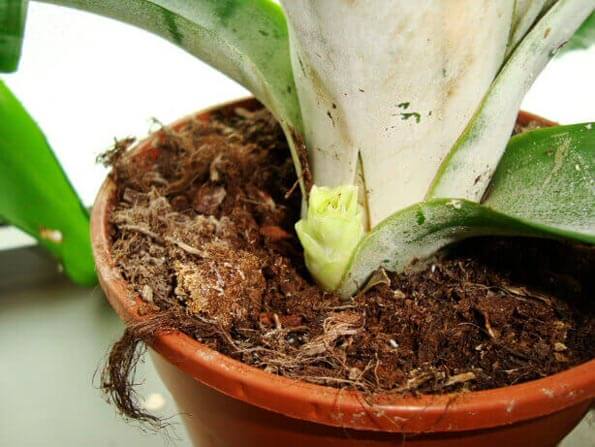
An Offset growing at the base of an Urn Plant.
If you want to give it a try, make sure you only attempt it on a reasonably mature / large offset that's been growing for at least a few months, if it's very small just wait a bit longer until it's bigger.
When it's ready, use a sharp knife to increase accuracy and once severed, pot into ordinary potting compost and treat like you have the adult plant previously.
Air Plants
Aloe
Dwarf Banana
Echeveria
Haworthia
Lady Palm
Pilea Peperomioides
Pink Quill Plant
Urn Plant
With some houseplants, Plantlets appear on the end of long flowering stems. These are basically miniature adult plants and when the leaves and roots have formed and have grown to a decent size they're ready to live life on their own.
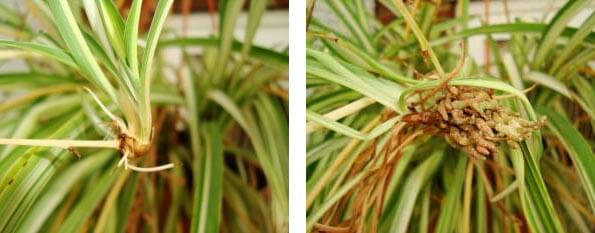
Even though one has more roots than the other both these Spider Babies can be propagated easily.
You just need to remove the plantlet and pot up into a standard soil mix, watering well, then within a few weeks you'll notice brand new growth. One houseplant is propagated this way more than any other and that's the Spiderplant.
Moth Orchid
Pilea Peperomioides
Spiderplant
Many houseplants can be propagated through Stem or Cane cuttings. If you're going to use a stem cutting, pick non-flowering stems and do it during Spring or Summer.
The majority of cuttings should be gently inserted into the compost as soon as they have been cut from the main plant. If you're using cuttings from cacti or succulent type plants give them at least a few hours to a day in order for them to dry out a little, this seals the raw "cut" slightly and reduces the possibility of rot setting in.

A Yucca Plant shoot growing from a cane cutting. Photo by Arnulf zu Linden.
Cane cuttings are a good choice when the cane has lost its upper leaves, the crown is dying or the plant has a tall but undesirable "leggy" appearance and you want to encourage new shoots to sprout lower down.
When you remove the cane simply cut it into pieces at least 2 - 3 inches long (how many cuttings you get per cane will therefore depend how long it is to start with ) and push upright into the compost, you must make sure the cane is still pointing upwards to mirror the direction it was growing in when attached to the main plant.
African Milk Tree (Stem)
Begonia (Cane)
Corn Plant (Cane)
Crown of Thorns (Stem)
Dragon Tree (Cane)
Dumb Cane (Cane)
Goosefoot / Syngonium (Stem)
Jewel Orchid (Stem)
Senecio / String of Pearls (Stem)
Star Jasmine (Stem)
Swiss Cheese Plant / Monstera (Stem)
Pothos (Stem)
Wandering Jew (Stem)
Yucca (Cane)
Depending on the plant you'll need to either gently pull or cut off a leaf from the stem, allow the raw edge to dry slightly (few hours to a day) and then pot it up in a free draining compost mix with the raw edge going in first.
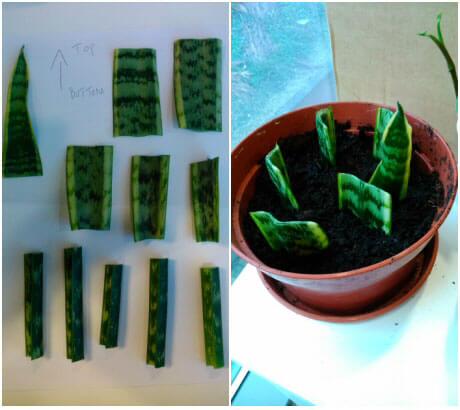
Snake Plant leaf cuttings.
Some plants like the Sansevieria have massive leaves, which although a little more drastic, can be cut into several smaller pieces (see opposite).
Always plant in the direction of growth, keeping most of the leaf above the ground which prevents rotting and allows for photosynthesis to take place which in turn creates the new growth you need. Only a few centimeters of the leaf needs to actually be in the soil, just enough to hold it in place. Keep warm and water very occasionally.
African Violet
Begonia
Christmas Cactus
Easter Cactus
Echeveria
Jade Plant
Mother-in-Law's Tongue / Snake Plant
Wandering Jew
Zamioculcas Zamifolia
Seeds are normally the cheapest method and attain the best value when looking to obtain new house plants through propagation (ask any outdoor gardener). The downside is that only a few indoor plants will produce viable seeds to even allow you to attempt this.
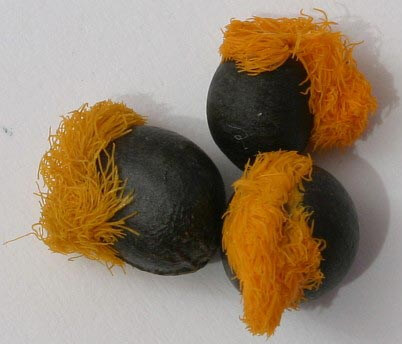
Bird of Paradise Seeds. Photo by Sebastian Stabinger.
The clear disadvantage here is that it takes time for germination to occur and then a great deal more for the seedlings to reach a decent size. It can still be worth a try and if your houseplant has given you some you've nothing to lose in trying to grow some new plants from seed.
Make sure you use fresh compost and keep temperatures at the correct level to encourage seed germination. If you have a greenhouse or heated propagator, this will be a valuable piece of kit. Once germination happens you must take extra care to keep the seedlings in a protected condition as their small size makes them vulnerable to damage.
Chrysanthemum
Gerbera
Stephanotis
Strelitzia
Umbrella Grass
The majority of climbing house plants will produce "runners" of stray, exploitative vines or stems that will root into new soil if given the chance. This is called "layering" and is a really reliable way of creating new plants if you don't want to take the greater risk of a standard stem cutting.
The downside is that it takes quite a while before rooting has taken place, you also need to have space to work with as the propagating happens right where the new growth actually is, i.e. next to the parent.
Once the stem(s) have been chosen, use a hairpin or a piece of flexible wire that allows you to pin the stem into a small pot filled with compost. Ensure the stem is pushed slightly under the soil surface as contact must be made in order for roots to form.
The parent will continue to fuel the stem until rooting has taken place, once this happens you will notice new growth and at this point it can be cut lose from the parent and just like that the smaller pot contains your new self-sufficient plant.
Goosefoot / Syngonium
Ivy
Monstera Albo / Monstera Thai Constellation
Pothos
Spider Plant
Sometimes one of your houseplants might get too wide or spread so you can reduce its size and also create new plants at the same time by dividing it. You can divide it perhaps in two, or even into more smaller "pieces" or "clumps" if you want multiple plants.
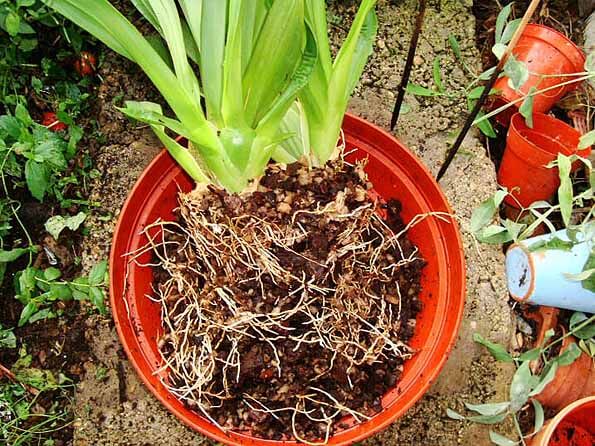
You can divide congested houseplants to create new ones.
Division is normally very easy as all you need to do is remove the plant from its pot and gently pull the roots apart.
Just remember that each "piece" or "clump" must have its own root ball, otherwise it will be very vulnerable to drying out. In the photo above you should be able to see two distinct plants starting to emerge during the splitting process, each with their own set of roots.
Out in the garden you might use a spade to do this, although this is not advised for indoor plants as they tend not to be so accommodating of really rough treatment, so do it by hand (or a sharp knife if it's too tough).
Aspidistra
Boston Fern
Calathea
Cambria and Vuylstekeara Orchids
Dumb Cane
Peace Lily
Pitcher Plant
Purple Shamrock
Snake Plant
Umbrella Grass

Hi, I'm Tom!
If you're like me and enjoy the challenge of growing houseplants and getting them to thrive, then Ourhouseplants can help. This website shares my knowledge and years of growing plants and provides (hopefully) helpful advice on properly caring for your indoor plant friends.